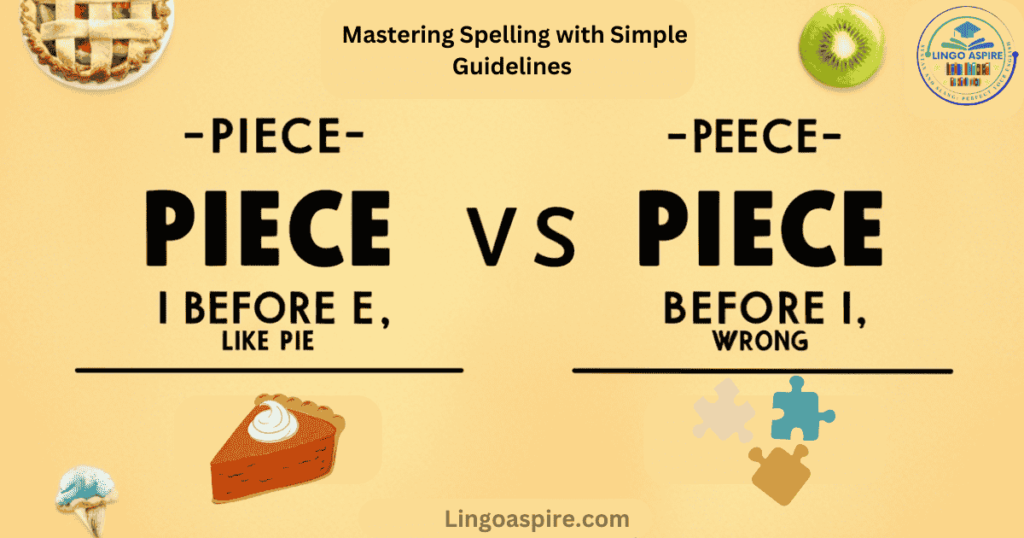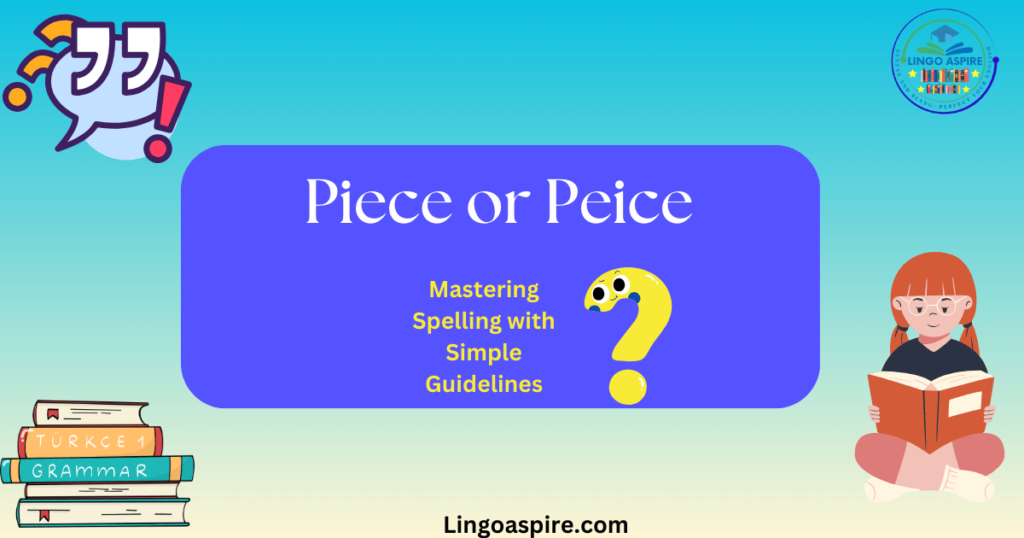In English, some words cause more than their fair share of confusion due to similar sounds but different spellings. A prime example is the mix-up between “piece” and “peice.” Such common spelling errors not only disrupt sentence flow but can also hinder effective communication. This article will delve into the correct spelling of “piece,” illustrating its proper everyday usage. It’s dissecting why “peice” emerges as a common misspelling. By clarifying these points, we aim to enhance your writing clarity and vocabulary improvement. Ensuring you convey your messages accurately and professionally.
Understanding ‘Piece’: The Correct Spelling
“Piece,” meaning a part or portion of something, is used in contexts like sharing cake or offering advice. Using “piece” correctly is essential for effective communication and helps convey messages clearly and professionally in all settings. Precision in language reflects competence, particularly in professional communication, where accuracy is highly valued and expected by your audience. Recognizing the correct usage of “piece” prevents typographical errors and improves both written and spoken English significantly.
Understanding ‘Piece’: The Correct Spelling
The word “piece” stems from the Old French pièce, which itself originated from the Latin pettia, meaning a part, or segment. Over time, “piece” has evolved in the English language to denote a portion of something larger, whether tangible or figurative.
In its correct usage, “piece” can significantly enhance the precision and clarity of communication, especially in writing and everyday usage. Below is a table that illustrates different contexts in which “piece” is correctly used.
| Context | Example |
|---|---|
| Culinary | Could I have a piece of that chocolate cake? |
| Advice | She gave me a valuable piece of advice on job application writing. |
| Art | He bought a beautiful piece by a local painter. |
| Music | We enjoyed a soothing piece from Mozart. |
| Writing | Please read this piece I wrote on effective communication. |
Each example demonstrates how “piece” integrates into various aspects of life, emphasizing its importance in maintaining professionalism and writing clarity. By understanding and applying the correct spelling of “piece,” individuals can avoid common errors and improve their overall communication skills and English language proficiency.
Exploring the Common Error: ‘Peice’
The spelling “peice” is incorrect, but it frequently appears in written English. This common error often arises from the confusing English rule “i before e except after c,” which has numerous exceptions, leading to phonetic misinterpretation and spelling mistakes.
Psychologically, people often write words based on their sound, known as phonetic spelling, leading to errors like “peice.” The sequence of ‘i’ and ‘e’ is tricky in English, causing reliance on sound over proper spelling rules. Irregularities in English spelling compared to its phonetic representation further complicate the process for learners and native speakers alike. These challenges explain why even those fluent in English frequently make errors in spelling tricky words like “piece.”
Furthermore, rapid typing and lack of proofreading can exacerbate these errors, especially in informal settings or under time pressures. The brain’s autocorrect feature often misses errors because it prioritizes sentence flow and meaning over individual word spelling. This shows how regular reading habits and familiarity with common spelling mistakes improve writing clarity and communication effectiveness.
The Significance of Spelling Correctly
Correct spelling is pivotal in ensuring effective communication across various contexts—academic, professional, and personal. It not only reflects an individual’s proficiency in the English language but also enhances the clarity and credibility of the communication. In professional settings, for instance, precise spelling is key to establishing professionalism and can significantly impact the reception of a message or document.
The consequences of spelling errors can be profound. For example, a misspelled word in a business proposal can lead to misinterpretation of the content, potentially costing a company valuable opportunities. In personal communication, a simple error like misspelling “dessert” as “desert” can change a dinner invitation’s meaning, leading to amusing but confusing exchanges.
Academically, incorrect spelling can lower the perceived quality of a student’s work, affecting grades and assessments of their knowledge. Misunderstandings due to spelling errors are common and can often be avoided by regular practice, the use of effective writing tools, and proofreading. Thus, mastering correct spelling is essential for maintaining writing clarity, enhancing effective communication, and ensuring messages are received as intended.
Tools and Techniques for Accurate Spelling

In the digital age, spell checkers and grammar tools are invaluable for ensuring accurate spelling. These tools operate by comparing the words you type against a comprehensive database of correct spellings. When a word doesn’t match an entry in the database, the tool flags it as a potential error, suggesting alternatives. However, their effectiveness is limited by the complexity of language; for instance, they might not recognize context-specific terms or differentiate between homophones like “there” and “their.”
To use grammar checkers effectively, it’s important not to rely solely on them. Here are some best practices:
- Double-check suggestions: Always review the corrections suggested by these tools, as they can sometimes misinterpret the context, leading to incorrect replacements.
- Learn from corrections: Use the feedback from spell checkers as a learning tool. Understand why a correction is made to avoid similar mistakes in the future.
- Combine tools with traditional proofreading: Despite their utility, digital tools cannot replace a thorough manual review, especially for nuances like sentence flow and writing clarity. Always read your work aloud or have another person review it.
By integrating these techniques with regular use of digital aids, you can enhance your spelling accuracy, reduce writing errors, and improve overall communication skills.
Style Guides and Their Role in Spelling
Style guides play a crucial role in maintaining consistency and clarity in writing across various formats and disciplines. They are particularly vital in academic and professional settings, where they help standardize citations, grammar, formatting, and, importantly, spelling. This consistency is essential not only for professionalism but also for ensuring that documents are accessible and understandable to all readers.
Popular style guides such as the APA (American Psychological Association), MLA (Modern Language Association), and Chicago Manual of Style provide detailed rules on language usage. For example, the APA style guide emphasizes clarity and conciseness, offering specific guidelines on how to handle technical terms and common spelling errors. MLA focuses on the liberal arts and humanities, providing guidance on the use of language that is inclusive and free from biased terminology. The Chicago Manual spans a variety of subjects, offering robust advice on everything from the serial comma to the correct spelling of complex words.
These guides also address common misspellings and typographical errors by providing clear examples. For instance, they may clarify the spelling of frequently confused words like “complement” vs. “compliment,” ensuring writers are aware of the distinctions, thus enhancing their writing clarity and effectiveness in communication. By adhering to these guidelines, writers can significantly improve their spelling accuracy and overall writing quality.
Real-World Applications of ‘Piece’
The word “piece” is not just a part of the English vocabulary; it permeates everyday language and professional writing, reinforcing the importance of correct spelling for clear communication.
‘Piece’ in Everyday Expressions
In cultural phrases and idioms, “piece” often appears, carrying meanings that extend beyond the literal. Expressions like “a piece of cake” imply something is easy to do, while “a piece of one’s mind” refers to candidly expressing one’s thoughts or opinions. These idioms enrich the English language, providing vivid ways to convey messages in a compact form. Misinterpreting or misspelling “piece” in these expressions could distort the meaning, potentially leading to misunderstandings.
‘Piece’ in Professional Writing
In professional contexts, the accurate spelling of “piece” is equally critical. Whether in business documents, literary works, or academic papers, “piece” is used to describe elements of a larger whole, such as a piece of evidence in a research paper or a piece of strategic advice in a consultancy report. The correct use of “piece” contributes to the credibility and professionalism of the text, enhancing the writer’s reputation for precision and attention to detail.
Below is a table showcasing examples of “piece” in various real-world contexts:
| Context | Example Usage |
|---|---|
| Idiomatic | “Getting the permit was a piece of cake.” |
| Business | “She presented a key piece of the proposal.” |
| Literary | “He wrote a fascinating piece on surrealism.” |
| Academic | “This study is a critical piece of our thesis.” |
| Advisory | “I took his words as a piece of valuable advice.” |
Each example illustrates how the correct spelling and application of “piece” are vital across different settings, underscoring the word’s flexibility and significance in both casual and formal communication. This versatility makes it essential to master its usage and spelling, enhancing both everyday interactions and professional exchanges.
Frequently Asked Questions
- What is the difference between “piece” and “peice”?
“Piece” is the correct spelling, referring to a part of something larger, whereas “peice” is a common misspelling and not recognized as a correct word in English. - Why do people often misspell “piece” as “peice”?
This error usually occurs due to the confusing rule “i before e except after c,” combined with phonetic misinterpretation where the sounds of the letters don’t clearly indicate their order. - What are some tips to avoid misspelling “piece”?
Remember the phrase “a piece of pie” to help recall the correct sequence of ‘i’ and ‘e’. Both “piece” and “pie” place ‘i’ before ‘e’. - Can you list some other commonly misspelled words?
Yes, words like “necessary,” “accommodate,” “separate,” and “definitely” often challenge spellers. - How can I improve my overall spelling accuracy?
Regular reading, using spell check and grammar tools, and engaging in word games or vocabulary building activities can significantly enhance your spelling skills. - Why is correct spelling important in professional communication?
Correct spelling enhances the readability and professionalism of your communications, which can influence your credibility and effectiveness in conveying messages. - Are there effective methods to learn the correct spelling of tricky words?
Yes, creating mnemonic devices, keeping a personal list of troublesome words, regularly practicing spelling, and using resources like style guides and spelling apps can greatly aid in learning correct spellings.
Conclusion
Throughout this discussion, we’ve explored the crucial distinctions between “piece,” the correct spelling, and “peice,” a common error. Understanding the correct use of “piece” in various contexts, from everyday expressions to professional writing, underscores its importance in effective communication. We’ve also delved into the reasons behind common spelling mistakes and the tools and techniques that can help mitigate them, including the invaluable role of style guides in maintaining spelling consistency.
Please share your experiences or any challenges you’ve faced with spelling in the comments below. Your insights could help others who are working to overcome similar obstacles. Let’s learn from each other and strive for excellence in our written and spoken words.
Sources
- Merriam-Webster Dictionary
A trusted resource for definitions, correct spellings, and language tips. - Grammarly Blog
Comprehensive articles on grammar, spelling, and writing tips, including how to avoid common spelling mistakes. - Purdue Online Writing Lab (OWL)
A valuable resource for learning about style guides, grammar rules, and improving writing clarity.







